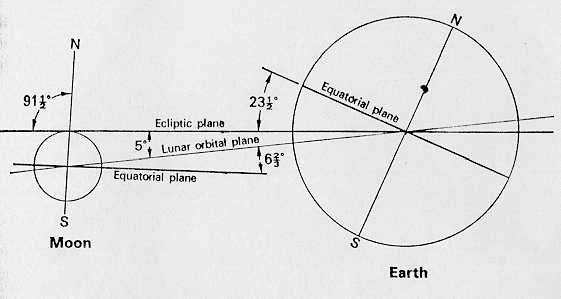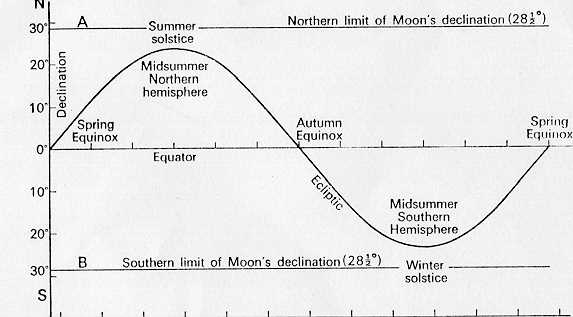View of the Moon
Definitions
ecliptic
as the earth moves around the sun, a plane is defined
at all times, this plane is refered to as the ecliptic
meridian
the great circle of the sky through the two celestial
poles and the zenith, it divides the sky ino eastern and western
halves
zentith
the point in the sky directly overhead, 90 degrees from
the horizon
celestial sphere
the "bowl of the sky", to the ancients, this
is the apparent sphere of sky encircling the earth on which the
stars appear to be fixed
lunar orbit
the moon's path around earth
Explanation
The moon's path on the celestial sphere is close to the ecliptic
but tilted some 5 degrees. For this reason, sometimes when the
moon crosses the meridian for an observer in the U.S. it is
higher in the sky than at other times.
A similar phenomenon occurs with the sun as we see it from
earth. The earth is also tipped and maintains the direction
of tip without any change thoughout the year. Because of this,
at one point in the year, the North Pole is tipped towards the
sun and the South Pole is tipped away form the sun and vise
versa.
The following illustration should help you grasp this concept.

Notice that the earth's equatorial plane is tilted at an
angle to the ecliptic plane.
The lunar orbital plane is inclined to the ecliptic as well.
Because of this, the moon can be overhead in latitudes of
plus or minus 28.5 degrees.
The following graph helps illustrate the variation of the
moons latitude.

Questions to Consider
Looking at the first illustration, imagine you were at the
earth's equator. Would the moon appear low or high in the
sky? Still looking at the first figure, trace the path of
the moon around earth on the lunar orbital plane. When the
moon has gone half way around the earth from the position
which the illustration shows, will it appear high or low
in the sky to a person on the earth's equator? If you were
standing on the moon, looking at earth, would it appear to
change elevation in the sky?

